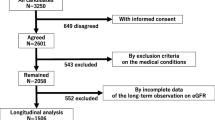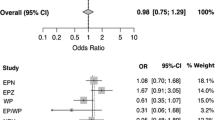Abstract
The object of this study was to determine the association of Trp64Arg polymorphism with hyperuricemia. This study is an age-matched, case-controlled study of 203 hyperuricemic and 203 normouricemic men. The frequency of genotypes was compared between the two groups. Possible confounding metabolic variables were included in a multiple logistic regression model for multivariate adjustment. The genotype frequencies of Trp64Trp, Trp64Arg, and Arg64Arg in hyperuricemic and normouricemic groups are respectively 130, 69, and 4 (64.0%, 34.0%, 2.0%) and 154, 45, and 4 (75.9%, 22.2%, 2.0%) (P = 0.029, Chi-square test). Simple logistic regression analysis indicated that the Trp64Arg genotype is significantly associated with hyperuricemia (OR = 1.816, 95% CI (1.167–2.827), P = 0.008). Multivariate analysis for controlling metabolic effects also showed a significant association with the occurrence of hyperuricemia (OR = 1.937, 95% CI (1.149–3.266), P = 0.013). Trp64Arg polymorphism of the beta-3 adrenergic receptor may be independently associated with hyperuricemia in males.
Similar content being viewed by others
References
Brixner DI, Ho MJ (2005) Clinical, humanistic, and economic outcomes of gout. Am J Manag Care 11:S459–S464
Choi HK, Mount DB, Reginato AM (2005) Pathogenesis of gout. Ann Intern Med 143:499–516
Vazquez-Mellado J, Alvarez Hernandez E, Burgos-Vargas R (2004) Primary prevention in rheumatology: the importance of hyperuricemia. Best Pract Res Clin Rheumatol 18:111–124
Reaven GM (1988) Banting lecture 1988. Role of insulin resistance in human disease. Diabetes 37:1595–1607
Third Report of the National Cholesterol Education Program (NCEP) (2002) Expert panel on detection, evaluation, and treatment of high blood cholesterol in adults (Adult Treatment Panel III) final report. Circulation 106:3143–3421
Rho YH, Choi SJ, Lee YH, Ji JD, Choi KM, Baik SH, Chung SH, Kim CG, Choe JY, Lee SW, Chung WT, Song GG (2005) The prevalence of metabolic syndrome in patients with gout: a multicenter study. J Korean Med Sci 20:1029–1033
Bonora E, Targher G, Zenere MB, Saggiani F, Cacciatori V, Tosi F, Travia D, Zenti MG, Branzi P, Santi L, Muggeo M (1996) Relationship of uric acid concentration to cardiovascular risk factors in young men. Role of obesity and central fat distribution. The Verona Young Men Atherosclerosis Risk Factors Study. Int J Obes Relat Metab Disord 20:975–980
Takahashi S, Yamamoto T, Tsutsumi Z, Moriwaki Y, Yamakita J, Higashino K (1997) Close correlation between visceral fat accumulation and uric acid metabolism in healthy men. Metabolism 46:1162–1165
Malecki MT, Klupa T (2005) Type 2 diabetes mellitus: from genes to disease. Pharmacol Rep 57(Suppl):20–32
Walston J, Silver K, Bogardus C, Knowler WC, Celi FS, Austin S, Manning B, Strosberg AD, Stern MP, Raben N et al (1995) Time of onset of non-insulin-dependent diabetes mellitus and genetic variation in the beta 3-adrenergic-receptor gene. N Engl J Med 333:343–347
Widen E, Lehto M, Kanninen T, Walston J, Shuldiner AR, Groop LC (1995) Association of a polymorphism in the beta 3-adrenergic-receptor gene with features of the insulin resistance syndrome in Finns. N Engl J Med 333:348–351
Clement K, Vaisse C, Manning BS, Basdevant A, Guy-Grand B, Ruiz J, Silver KD, Shuldiner AR, Froguel P, Strosberg AD (1995) Genetic variation in the beta 3-adrenergic receptor and an increased capacity to gain weight in patients with morbid obesity. N Engl J Med 333:352–354
Strosberg AD (1997) Structure and function of the beta 3-adrenergic receptor. Annu Rev Pharmacol Toxicol 37:421–450
Tchernof A, Starling RD, Turner A, Shuldiner AR, Walston JD, Silver K, Poehlman ET (2000) Impaired capacity to lose visceral adipose tissue during weight reduction in obese postmenopausal women with the Trp64Arg beta3-adrenoceptor gene variant. Diabetes 49:1709–1713
Shiwaku K, Nogi A, Anuurad E, Kitajima K, Enkhmaa B, Shimono K, Yamane Y (2003) Difficulty in losing weight by behavioral intervention for women with Trp64Arg polymorphism of the beta3-adrenergic receptor gene. Int J Obes Relat Metab Disord 27:1028–1036
Hsueh WC, Cole SA, Shuldiner AR, Beamer BA, Blangero J, Hixson JE, MacCluer JW, Mitchell BD (2001) Interactions between variants in the beta3-adrenergic receptor and peroxisome proliferator-activated receptor-gamma2 genes and obesity. Diab Care 24:672–677
Phares DA, Halverstadt AA, Shuldiner AR, Ferrell RE, Douglass LW, Ryan AS, Goldberg AP, Hagberg JM (2004) Association between body fat response to exercise training and multilocus ADR genotypes. Obes Res 12:807–815
Koda M, Ando F, Niino N, Shimokata H, Miyasaka K, Funakoshi A (2004) Association of cholecystokinin 1 receptor and beta3-adrenergic receptor polymorphisms with midlife weight gain. Obes Res 12:1212–1216
Matthews DR, Hosker JP, Rudenski AS, Naylor BA, Treacher DF, Turner RC (1985) Homeostasis model assessment: insulin resistance and beta-cell function from fasting plasma glucose and insulin concentrations in man. Diabetologia 28:412–419
Ruilope LM, Garcia-Puig J (2001) Hyperuricemia and renal function. Curr Hypertens Rep 3:197–202
Campion EW, Glynn RJ, DeLabry LO (1987) Asymptomatic hyperuricemia. Risks and consequences in the Normative Aging Study. Am J Med 82:421–426
Halliburton R (2004) Introduction to population genetics. Pearson Prentice Hall, New Jersey
Snaith M (2004) A (very) short history of diets for gout. Rheumatology (Oxford) 43:1054
Leineweber K, Buscher R, Bruck H, Brodde OE (2004) Beta-adrenoceptor polymorphisms. Naunyn Schmiedebergs Arch Pharmacol 369:1–22
Fujisawa T, Ikegami H, Kawaguchi Y, Ogihara T (1998) Meta-analysis of the association of Trp64Arg polymorphism of beta 3-adrenergic receptor gene with body mass index. J Clin Endocrinol Metab 83:2441–2444
Kurokawa N, Nakai K, Kameo S, Liu ZM, Satoh H (2001) Association of BMI with the beta3-adrenergic receptor gene polymorphism in Japanese: meta-analysis. Obes Res 9:741–745
Zhan S, Ho SC (2005) Meta-analysis of the association of the Trp64Arg polymorphism in the beta3 adrenergic receptor with insulin resistance. Obes Res 13:1709–1719
Pietri-Rouxel F, St John Manning B, Gros J, Strosberg AD (1997) The biochemical effect of the naturally occurring Trp64–>Arg mutation on human beta3-adrenoceptor activity. Eur J Biochem 247:1174–1179
Kimura K, Sasaki N, Asano A, Mizukami J, Kayahashi S, Kawada T, Fushiki T, Morimatsu M, Yoshida T, Saito M (2000) Mutated human beta3-adrenergic receptor (Trp64Arg) lowers the response to beta3-adrenergic agonists in transfected 3T3-L1 preadipocytes. Horm Metab Res 32:91–96
Perfetti R, Hui H, Chamie K, Binder S, Seibert M, McLenithan J, Silver K, Walston JD (2001) Pancreatic beta-cells expressing the Arg64 variant of the beta(3)-adrenergic receptor exhibit abnormal insulin secretory activity. J Mol Endocrinol 27:133–144
Shihara N, Yasuda K, Moritani T, Ue H, Adachi T, Tanaka H, Tsuda K, Seino Y (1999) The association between Trp64Arg polymorphism of the beta3-adrenergic receptor and autonomic nervous system activity. J Clin Endocrinol Metab 84:1623–1627
Walston J, Andersen RE, Seibert M, Hilfiker H, Beamer B, Blumenthal J, Poehlman ET (2003) Arg64 beta3-adrenoceptor variant and the components of energy expenditure. Obes Res 11:509–511
Savage DB, Petersen KF, Shulman GI (2005) Mechanisms of insulin resistance in humans and possible links with inflammation. Hypertension 45:828–833
Arch JR (2001) The beta 3-adrenergic system and beta 3-adrenergic agonists. Rev Endocr Metab Disord 2:385–393
Arch JR (2002) Beta(3)-Adrenoceptor agonists: potential, pitfalls and progress. Eur J Pharmacol 440:99–107
Mark AL, Rahmouni K, Correia M, Haynes WG (2003) A leptin-sympathetic-leptin feedback loop: potential implications for regulation of arterial pressure and body fat. Acta Physiol Scand 177:345–349
Modan M, Halkin H, Karasik A, Lusky A (1987) Elevated serum uric acid—a facet of hyperinsulinaemia. Diabetologia 30:713–718
Quinones-Galvan A, Ferrannini E (1997) Renal effects of insulin in man. J Nephrol 10:188–191
Fruehwald-Schultes B, Peters A, Kern W, Beyer J, Pfutzner A (1999) Serum leptin is associated with serum uric acid concentrations in humans. Metabolism 48:677–680
Matsubara M, Chiba H, Maruoka S, Katayose S (2002) Elevated serum leptin concentrations in women with hyperuricemia. J Atheroscler Thromb 9:28–34
Bedir A, Topbas M, Tanyeri F, Alvur M, Arik N (2003) Leptin might be a regulator of serum uric acid concentrations in humans. Jpn Heart J 44:527–536
Strazzullo P, Iacone R, Siani A, Cappuccio FP, Russo O, Barba G, Barbato A, D’Elia L, Trevisan M, Farinaro E (2001) Relationship of the Trp64Arg polymorphism of the beta3-adrenoceptor gene to central adiposity and high blood pressure: interaction with age. Cross-sectional and longitudinal findings of the Olivetti Prospective Heart Study. J Hypertens 19:399–406
Wang G, Li Q, Niu T, Chen C, Xu X (2002) Association of GYS1 and beta(3)-AR gene with postprandial hyperglycemia and serum uric acid in type 2 diabetes mellitus. Chin Med J (Engl) 115:1308–1311
Choi HK, Atkinson K, Karlson EW, Willett W, Curhan G (2004) Alcohol intake and risk of incident gout in men: a prospective study. Lancet 363:1277–1281
Choi HK, Curhan G (2004) Beer, liquor, and wine consumption and serum uric acid level: the Third National Health and Nutrition Examination Survey. Arthritis Rheum 51:1023–1029
Mandell BF (2002) Hyperuricemia and gout: a reign of complacency. Cleve Clin J Med 69:589–590, 592–583
Krief S, Lonnqvist F, Raimbault S, Baude B, Van Spronsen A, Arner P, Strosberg AD, Ricquier D, Emorine LJ (1993) Tissue distribution of beta 3-adrenergic receptor mRNA in man. J Clin Invest 91:344–349
Cockcroft DW, Gault MH (1976) Prediction of creatinine clearance from serum creatinine. Nephron 16:31–41
Author information
Authors and Affiliations
Corresponding author
Additional information
This study was supported by the Brain Korea 21 Project in 2004.
Rights and permissions
About this article
Cite this article
Rho, Y.H., Choi, S.J., Lee, Y.H. et al. The association between hyperuricemia and the Trp64Arg polymorphism of the beta-3 adrenergic receptor. Rheumatol Int 27, 835–839 (2007). https://doi.org/10.1007/s00296-006-0300-7
Received:
Accepted:
Published:
Issue Date:
DOI: https://doi.org/10.1007/s00296-006-0300-7




